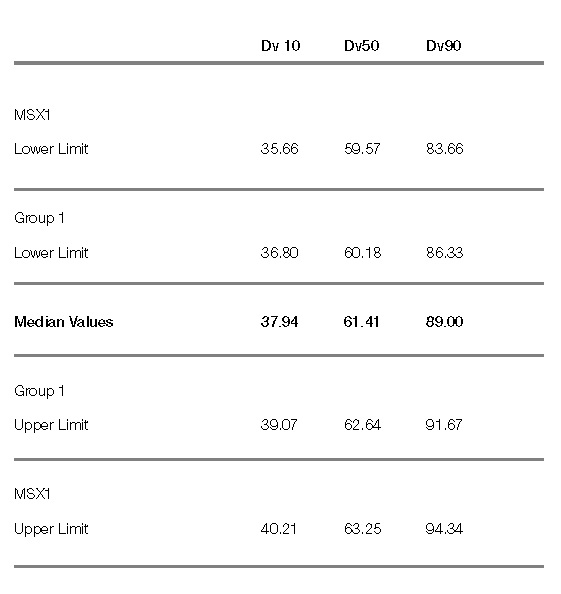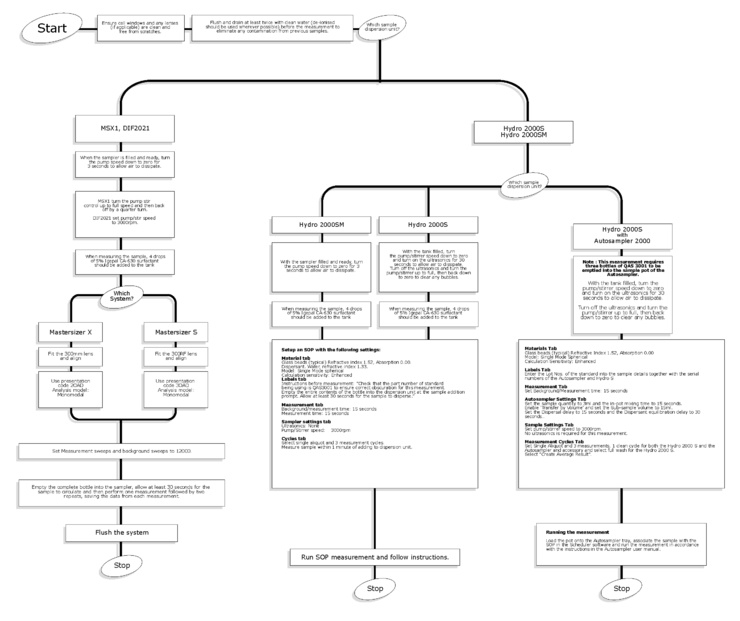입도 기준 시료를 이용한 기기 검증 방법 안내 – 입도 (QAS 3001)
Malvern Validation Initiative
Measurement protocols for Quality Audit Standard QAS3001
Single shot Polydisperse transfer standard for:
MSX1, DIF2021, Hydro 2000S,Hydro 2000SM
Also suitable as a multi-shot standard for checking the Hydro 2000S with Autosampler 2000
Introduction
Malvern’s QAS3001 Audit Standard has been produced to continue to provide users of Malvern particle size analysers with a reliable one-shot
polydisperse transfer standard to enable them to check the good performance of their sample dispersion units on a regular basis.
This standard replaces Malvern’s QAS2001 launched in 1999, supplies of which are finally at an end after 6 years of successful use. They have been produced from a new Master batch of 1000 Kg (Batch 02) which is actually the largest Master batch of any sizing standard ever produced anywhere in the world.
The size of this new Master batch will give users an automatic assurance that QAS3001 will be available as a sizing reference for even longer than the QAS2001 standard which originated from a 250 Kg Master batch.
Assuring continuity of results from QAS2001.
All the data on which the pass/fail criteria for the QAS3001 Audit Standard have been based has been obtained from sample dispersion units which have first been tested using QAS2001. This means that a unit which would have passed on the earlier standard will also pass using QAS3001.
One-shot packaging eliminates sampling error
The usual problem associated with the use of polydisperse glass bead standards from a bulk supply is that they are prone to segregation in transit so that sampling errors can occur. To overcome this, all
Malvern’s Quality Audit Standards have been produced by one of Europe’s leading suppliers of glass bead standards, Whitehouse Scientific Ltd. who have used an extremely efficient and accurate riffle
splitting process to ensure that each one-shot pot of the material is a representative sample of the whole bulk of sample material.
Comprehensive sampling of pots taken from the whole production run of the QAS3001 reference material has allowed us to average the data obtained at fixed size percentiles.
The Relative Standard Deviations on the d10, d50 and d90s derived from these tests are of the order of 0.2 to 0.3% which is actually within the repeatability which can be expected for the same well-dispersed sample recirculating within the measurement system.
An extensive programme of testing of Malvern’s sample dispersion units has been carried out to characterise the results which may be expected from them in order to establish pass/fail criteria for the purposes of Performance Verification (PV) testing of these units.
To ensure that the full benefit is obtained from the single shot sampling concept, it is essential that the entire contents of each bottle is consumed in a single measurement in accordance with the instructions on this leaflet.
The quality of the sampling from single shot sampling has been further enhanced by delivering the new standard in shoulderless bottles which minimise any possibility of retaining sample residues.
Compliance with ISO13320
Like QAS2001, QAS3002 complies with the requirements of ISO13320 relating to having a particle size distribution covering a decade of size and being used in conjunction with clear procedures (detailed in this document). They also have precisely specified optical properties and, being spherical in form, are also extremely useful for conducting round robins and inter-instrument comparisons.
Shelf life and Batch numbering
Unlike latex standards which are necessarily produced in small batches owing to the fact that they have a limited shelf life, Malvern Quality Audit Standards, being glass, are inert. Since they are also stored in sealed containers, they have an indefinite shelf life. Because of this, it has been possible to produce them from a single 1000Kg Master batch to yield many years of continuous supply. This means that the only batch number for QAS3001 is 02.
Traceability
These samples are traceable to NIST by a transfer method since they have been characterised on a reference Mastersizer 2000 which in turn has been verified using NIST-traceable polystyrene latices.
A fully documented programme of testing has been carried out to establish that the bottles are effectively identical to each other
to within 0.28%.
A change in the particle size distribution.
The particle size distribution of the new material is slightly larger than that of QAS2001. This has allowed us to slightly increase the challenge to the sample dispersion units, particularly the pumps and stirrers associated with the wet sample dispersion units.
Validating measurement procedures for the performance of Operational Qualifications.
Owing to the fact that this certificate is likely to have passed through a physical Distribution Network and may well have been stored for a period of time, the instructions and pass/fail criteria may have been superseded.
In case of doubt, the latest version number (MRK667-n) can be verified by visiting the Malvern Website (See contact details in the right-most column of this document). Where there is any disagreement between this certificate and the latest PV Certificate and Specification, the PV Certificate and Specification will be the master documents, since these are subject to strict change control and are automatically updated and Distributed to the Malvern Product Support Network electronically.
Expected results
QAS 3001 is designed for use on the following Group 1 units.
DIF2021, Hydro SM, Hydro S, Hydro S with Autosampler 2000
Expected limits (see table below) 2% on the Dv50 and 3% on the Dv10 and Dv90
MSX1
QAS3001 can also be used to check this sample dispersion unit but, owing to the fact that this unit does not have a pump speed read back or tacho control, the expected limits are 3% on the dv50 and 6% on the Dv10 and Dv 90.

Ongoing results from the same sample dispersion unit
The uniformity of the size distributions of bottles of QAS3001 is such that, provided that the standard is used as a single shot as intended, and the same measurement procedure is followed, the ongoing repeatability for any single sample dispersion unit is likely to be better than 1% on the d50 and 2% on the outlying percentiles for that unit.
Even if your unit is not listed under Expected Results, Malvern Quality Audit Standards will provide an invaluable means of bench-marking the performance of your sample handling unit on a regular basis.
Malvern Quality Audit Standards were first produced in 1999 as part of Malvern Instruments’ drive to be able to verify and document the uniform performance of their sample dispersion units throughout the world.
Sample dispersion units are set up at the Malvern facility under ideal conditions and are then distributed across the world and used in widely divergent operating environments.
With the passage of time, all analytical instruments need to be checked or re-calibrated and a transfer standard such as QAS3001 is the best method of checking whether an instrument is continuing to perform correctly.
In the case of sample dispersion units, subtle changes in pump and stir motors, the lengths of flexible tubing used and wear of stirrer blades and pump rotors can all have an insidious effect on their performance characteristics. Using a Quality Audit Standard to establish a baseline performance for a unit and then using it subsequently to check for changes in performance is a reliable means of checking and documenting continued consistency to meet the requirements of the FDA and International Laboratory Accreditation Schemes (ISO, NAMAS, IAF etc)
This data sheet aims to provide users with an indication of the results that they should expect from performing measurements using these standards.
Owing to the fact that it is only possible to establish an accurate baseline on new systems at the point of production, it is has not been possible to provide pass/fail criteria for older systems which were either no longer in production or where a significant proportion of systems was already in use at the time that these standards were introduced.
However, since Malvern Quality Audit Standards are produced to such a high standard of reproducibility, they can be used to establish reliable in-house norms for any particle size analyser.
Health and Safety Data

